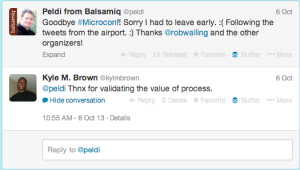 Introduction
Introduction
Ever notice that you are performing the same task over and over in your business? Such as answering the same questions from different employees or customers? Have you ever found yourself working on something and then realized as you are working that you have completed this same task many times in recent memory?
Wouldn’t it be nice if you could spend your time working on growing your business by developing brand new relationships with customers and focusing your time on strategy instead of menial task. Wouldn’t it be nice if your employees or customers could find the answers that they needed when they needed them in your own words just the way you would say it without asking you? How efficient would your business be if your employees could do things exactly the way that you would without having to come to you first and without being told by you to do those things. Suppose your customers could get the answers to their questions without calling or emailing you?
If your answer to any of the questions in the first paragraph is yes, then you should be automating repeatable task by documenting them with business processes. And although this will not the stop the task from occurring, it will remove you the business owner, from the cycle so that you can work on more important things like growing your business. If the answer to any of the questions in the second paragraph was yes, then you should continue reading and get started today.
What is a process?
There are many types of processes. What we are going to be writing about in this article specifically are processes that are related to business a.k.a business processes. Wikipedia defines a business process as “a series of actions or steps taken in order to achieve a particular end.” I like to define a business process as a set of authoritative steps that outline the methods required to achieve an objective.
On a side note there is, Automation, which is defined as “the process of self reliability.” That has such a good ring to it that I will write it again, ” the process of self reliability.” Thats what this game is all about people. The tools that are available today make automation affordable (sometimes free) and easy. Automation is by far one of the biggest benefits of technology.
Why do I need processes? (It only takes me a few minutes to do the task anyway)
In my practice I’ve heard much discussion around this question. Some of the responses I’ve heard are, “It only takes me a few minutes for me to do the task anyway”, “Common sense should tell you that”, and one of my favorites, “I don’t have time to document it because it takes too much time, I will just tell someone what to do” Well, those thoughts may be what some think and it may work for a while, but it’s not true if you want to scale your business and you will learn why as you read this content. There are multiple reasons to use processes in your business. A few of them are, efficiency, portability, consistency.
Efficiency
One of the most important reasons is efficiency. You can improve your businesses efficiency via process which means that you can reduce your operating cost to save both time and money. I can not place enough emphasis on the amount of time that can be saved by using processes in your business and time is money. If you know what your time is worth and you value it then you should be using processes in your business.

Portability
Processes help make your business portable. This is a huge benefit because it means that you can hand the keys to the car (your business) to someone else when you need to. It means that you are not walking around with all of the intellectual property that is required to operate your business inside of your head, which is not a good idea. However, In my practice this is very common with small startup businesses. Should something happen to you, your business is dead or operating inefficiently. Oddly enough It is also common inside of large companies at the departmental level. If an individual employee leaves or moves on to another organization within the company, someone else will need to start from scratch and piece together the processes required to serve in that role. Some may call this job security, I call it inefficiency.
If your business is structured using processes it is much easier for you to automate and outsource or use remote workers to perform all or some of the task required to run your business. You can obviously do this without processes but it will take much more time and effort because you will have to perform training each time and you cannot train without having defined processes first. This is also invaluable if you wish to sell the business at anytime in the future.
True Story about portability
I know someone who was approached to have their startup business purchased at 3 times its yearly earnings (8 figures is what I was told). One of the criteria for the sale was that the owner had to provide training and documentation for operating the business, or in other words, processes required to run the business. Easy right? It should only take a few hours?
Wrong! The business was 9 years old and the owner had never documented a thing. It was always something that he didn’t have time to do and would get to later. He had it all in his head and his undocumented process was for his employees to simply just ask him if they needed to know how to do something.
It worked so life was good. Why fix something that isn’t broken, right? Well, life is still good and in his mind things may still be working fine. The reason things are still working fine is because he never sold the company. The deal fell apart for one reason. The owner of the business could not get the necessary documentation together in a time that the prospective buyer was satisfied with. It turns out that it is not so easy to place 9 years of valuable lessons learned running the business into a documented process. As a matter of fact, It took months to complete and the buyer only had a window of a couple of weeks before the offer was taken off of the table. What the buyer wanted was a turnkey business that was on autopilot and process gives you that.

Consistency
Displaying a unified consistent voice to your customers and your employees is underrated and extremely important. During my practice, I have heard many business owners say to me that If you hire smart people then you don’t need processes because they will do and say the right thing. Another statement that is simply not always true. For starters, good help is hard to find and really smart people come with a price as well they should.
If you can find and afford to pay those smart people that’s great! However, even the smartest employee does not share your vision and will not see the business through the same lens that you see it. In fact, I was fortunate enough to attend MicroConf Europe 2013 in Prague. One of the speakers was Peldi’s of Balsamiq Mockups. During a Q and A session following his presentation, he confirmed that as his company grew to about ten employees, he had to create a company handbook. Can you guess what was inside of it? If you guessed processes, then you are correct.
He told a story about how he attempted to delegate a specific task at his company without such documentation; how he originally felt that hiring smart employees was enough and that the rest would work itself out. The results of that arrangement were in his words, “a complete disaster.” and It had nothing to do with the employees intelligence. Why then? It was because there was no unified consistent voice.
Here is my tweet to Peldi during the conference just after he left and was headed to the airport.

I plan to go into more detail about this story, the value of consistency, and many other process related topics in future post. If you want to hear more about it, just leave your email address in the form below labeled “Receive updates about process” and I will let you know when the next post is available.
Though I have digressed, this content was intended to be about one specific reason to use documented processes and that’s to remove you, the business owner, from the cycle of repeatable task by automating them.
Expectations
First off, I want to touch on something. You may have heard some things about processes and you may have heard nothing about them. There are good and bad opinions from all types of people all over the Internet. There have also been many books written on the subject. Process is a topic that has been discussed quite a bit and yet it seems to be one of those things for which there is no real clear answer on whether it’s really valuable enough to warrant your time as a business owner. This article may or may not answer that question for you but it will give you my perspective.
And my perspective is based on a decade of experience documenting processes as a business analyst for the largest (or second depending on the number of subscribers acquired for the quarter) Telecommunications company in the United States and while this experience was extremely educational at that level of business, what I learned when applying these things to my much smaller scale software/consulting business has been just as if not more valuable.
Documenting processes for your business is not difficult to do but It does require some time upfront to get started. It is also good to keep in mind that it is a long ball solution that will pay dividends to your bottom line over the duration of your business. It requires balance and proper implementation. For example, you maybe already documenting processes at times whether you know it or not. You are probably just not aware of it.
Take this scenario as an example. You receive a question from someone asking you how to do something. This could be face to face, a phone call or email. You respond by sending a detailed email explaining the answer. Then days later someone else ask you for the same exact information. The reason that you are being asked that same question is because you only made the answer available to the one individual that you responded to instead of documenting it, making people aware of the document and sharing it with everyone that could benefit from it.

Getting Started
While writing this article, I found a quote, “Anything that should be done more than once or that involves different workers over time should be documented.” That couldn’t be more accurate. Documenting your processes can be as easy as taking a task that you perform over and over again, placing the steps in a document that all of your employees and /or customers can access without your involvement. Automating it. It really is that simple at a high level.
At a basic level here is what you need to do to get started:
- Identify a tool or method to create a process document.
- What I do – A couple that I have used are Microsoft Word and Google Docs.
- Identify a place to store the document. It must be some place that anyone who needs it can get access to at anytime.
- What I do – If you are using Google Docs, then this has been cared for. I also use Dropbox and box for customers and contractors. NOTE: For more private processes I recommend using an internal secured networked drive and setting up VPN for your employees or customers. If you want a cloud solution then Amazon offers a VPC. I do not recommend storing these types of documents on portable media such as flash drives and DVDs. Processes can contain very proprietary information that you don’t want made available to the public.
- Choose the task that you want to automate with process. If this is your first time developing a process, make it something small. So that it doesn’t create a distraction.
- What I do – Some things that I have created processes for are; using google voice to make outgoing phone calls, vetting contractors on oDesk for hire.
- Identify a method of stepping through the process step-by-step from beginning to the end. Be sure that you include ever single step no matter how small you feel it is. Details matter!
- What I do – You could simply write these out with an ordered / numbered bulleted list in Word. What really works well for me is to use a Flow Chart application like Microsoft Visio , Pencil which is free, or Balsamiq Mockups, which has tools for creating flow charts.
In a future post I will create a chart that contains the tools that I used at the enterprise level and the alternative tools that I found to be just as useful as a bootstrapped start-up.
Taking a repeatable task and developing it into a process
And now, the section that you likely came here to read. This will be more painless than you might think. I am going to walk you through the steps that can be used to document a process. This isn’t the only way nor is there a right or wrong way. There is only the way that works for you. However, what this is, is a method that I developed and tweaked over time that has worked many times with success. Over time with practice you will develop your own style.
- Place the date of the documents creation and your name at the top – Important!
- Identify the objective of the process.
- In other words, clearly identify the repeatable task that you which to create the process for. Write it down next to the word “Objective” or “Purpose”
- Decide who the audience is for the process and write if next to the word “Audience”. If it’s a process that was written for customer support reps so that they know how to handle irate customers, then that’s the audience. On the other hand, if it’s a process that tells a virtual assistance how to book your travel, then that’s the audience.
- Document every step required to complete this task without overlooking any details.
- You could do this by brainstorming the steps. Then writing every step down ordering it from one through X.
- You could also, flow it out using any one of the aforementioned tools in the “Getting Started” section #4 above. I highly recommend this method. Flowing out a process will force you ask yourself questions that you have never thought about or asked yourself. Trust me, Its happened to me and to the business owners that I have worked with more times than not. It does not matter how well you feel that you know the task, this works!
- Place this information into a document so that it is clearly numbered by step in order.
- Use one of the aforementioned tools in the “Getting Started” section #1 above.
- Gather any necessary screenshots that you feel will help make your process as clear as possible.
- A picture is worth a thousand words and in regards to process this is especially true. Proper use of photos can reduce the amount of text making the process easier to consume.
- Add a revision section to the bottom of the document.
- This section should capture dates, the revision authors name, the change to the process and the reason for the change. This may seem like a waste of time but it will save lots of time and avoid confusion. It is a small but critical component.
- Place the document somewhere, preferably in the cloud if your environment permits, and notify the audience that it was developed for that it is exist and should be used going forward.
In a future post I will create a basic template that you can use to help get you started. I am also considering putting together a book on the subject of process for startups. Make sure you sign up to receive updates to get it.
Final points
There are many other things that are required to make process work for your business and I will write more about them going forward. For example, there is training to make sure that the employees understand the process, and there is compliance to insure that the process is being followed. Without those elements, all you have is a document. Get started today. Best of luck and contact me if you need any help.
P.S. If you found value in this content and you know someone who could use it. Please share it with your social circle. More to follow.
Kyle, thanks for referencing our article titled “7 Books to Read If You Want a Systematized Business That Runs Without You Successfully!” in your blog post.
I am one of the co-founders of SweetProcess and I am available to answer any question that your readers might have about how to document procedures and/or systematize their business.
So if you are reading this comment and have a question, go ahead, leave it as a comment and I will respond with an answer.
Cheers!
Great to met you Owen, thanks for dropping in. Looking forward to conversation around process.
Kyle,
Great article. This can really help a lot of companies and the people within them if they take heed to what you wrote and the tools (links) in the article.
Thanks Kevin. Hopefully folks will find value in it. More to come.
Hi,
Please Give few automation tools names.
Hi Pankil,
Please provide me with a specific objective and I will see what I can do.
Thanks,
Kyle
Hey, Kyle, great post!
I agree with all the points you have mentioned especially about consistency and efficiency of a business. In order to achieve something significant, owners and managers should approach their goals in a systematic and efficient manner with the use of solid processes, especially if they are tasks you perform daily.
But all the advantages you have mentioned are for nothing if documentation of your processes themselves are poorly executed. Most of the time, inefficiency and inconsistencies happen when there is no documentation to use as a reference for a task execution.
With your basic tips, I would also like to recommend an API that we love so much and use for almost everything we do. Documentation, progress tracking, assignment tracking, etc. It’s called Process Street. You can hear more about it from this podcast.
Hi Lenna,
Thanks for your feedback! I think you are quite right! Documentation is king and I speak to that in this article very often when working with companies. Process Street is a product that I am aware of but do not have in-depth details on how it works so thanks for the reference.